When Ponce de Leon claimed what he probably thought was
an island for Spain, he was technically, and unknowingly,
claiming All of North America including Canada and Alaska.
To understand St. Augustine's rightful place in
American history we have to start with British history.
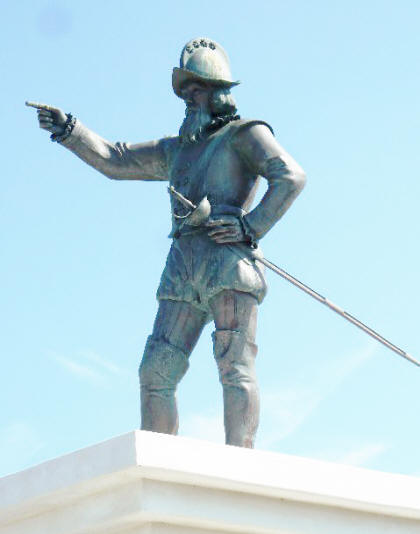 |
Newly erected Ponce de Leon
statute on A1A
10 miles north of St. Augustine
|
Jamestown, VA was founded 1607, abandoned in 1610 and
reestablished in 1616. The Pilgrims landed on that famous
rock in 1620.
In 1565, fifty-two years after Ponce
de Leon's landing, St. Augustine was founded by Pedro
Menendez de Aviles, an Admiral in Spanish Navy. This was 42
years, and in the century before the first Jamestown
settlement, and 55 years before the Pilgrims disembarked by
stepping onto that rock
But ask most people which is
the oldest European city in the continental USA and the
answer is usually Jamestown. Why? St. Augustine was Spanish
and Jamestown was English and as you well know, the victors
write the history books.
St. Augustine was the
capital of Spanish Florida for 200 years and is the oldest
continuously occupied European settlement and port in the
Continental United States. It remained the capital of East
Florida when the territory changed hands between Spain &
Great Britain in 1763 and was capital of the Florida
Territory (US) until it was moved to Tallahassee in 1824.
The heart of St. Augustine is at King and St. George
Streets. Everything radiates out from there;
sightseeing attractions, museums, restaurants and lodgings.
To get an overview of the city, its history and places of
interest, a trip on one of the hop-on/hop-off sightseeing
lines is the best way to get oriented.
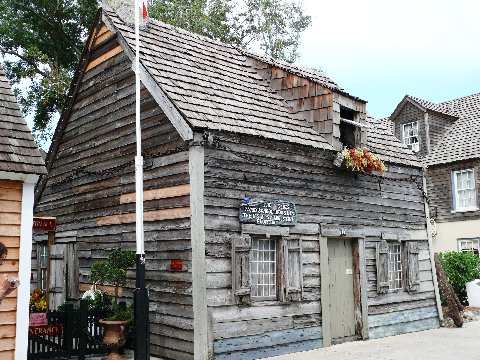 |
| 200 year old (plus) wooden
schoolhouse |
One block east of St. George St. is Aviles Street (Pedro
Menendez de Aviles), the oldest street in St. Augustine.
It's an easy walk south from King St. to the Gomez-Alvarez
House, the oldest house in St. Augustine. The cobblestone
streets and old homes are a photographer's delight. Ancient
coquina walls still show indents of invader's cannon balls.
Historic St. George St. north of King St. is
pedestrian friendly and lined with restaurants and shops
selling history, trinkets and T-shirts. Some visitors have
been heard to comment negatively on this use of such a
historic area without realizing that in the old days it was
taverns, buggy whips and muskets. It's always been a street
of merchants.
Most prominent in this area of the
city is Flagler College which was originally the Ponce de
Leon Hotel. Flagler College is today one of the top rated
4 yr liberal arts colleges in the country.
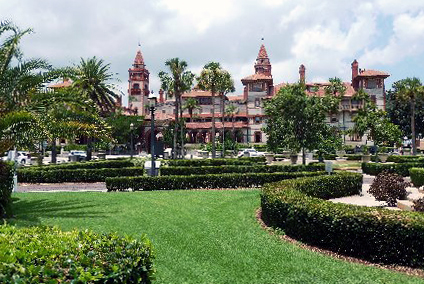 |
|
Flagler College
|
Built by Henry Flagler and opened in 1888, the hotel was the
height of luxury. It had every known modern amenity
for that time including electricity. The system was designed
by Flagler's friend Thomas Edison.
Being able
to turn lights on and off with a button was a novelty.
It was so new that some guests were afraid to touch the
buttons fearing they would be electrocuted. No problem.
The staff was at their disposal to do the deed.
The original museum quality art has been preserved
throughout the building. Dining room windows and leaded
glass decorations were designed by Louis Comfort Tiffany. I
believe the college has these treasures insured for an
amount in excess of $30 million.
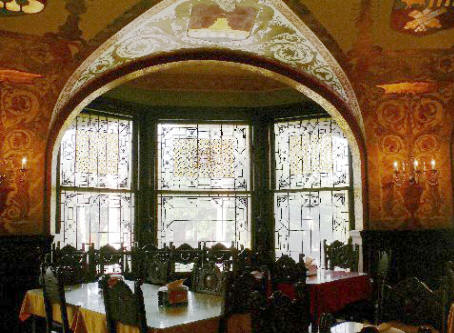 |
|
Flagler College dining room with some of the Tiffany
windows |
Today this magnificent building is home to students
studying, eating in the opulent dining room, socializing,
working their electronic devices and possibly no longer
aware of their fabulous surroundings after a couple of weeks
in residence.
A guided tour is the only way to see
and experience the building's magnificent interior since
security measures were imposed. Do take it. It's
really worthwhile.
In 1917 a publication called
Gullible's Travels published a humorous rendition of a
(supposed) visitor's reaction to visiting St. Augustine and
the Ponce de Leon Hotel:
"The hotel's named
after the fella that built it. He come from Spain and they
say he was huntin' for some water that if he'd drunk it he'd
feel young. I don't see myself how you could expect to feel
young on water. But, anyway, he'd heard that this here kind
o' water could be found in St. Augustine, and when he
couldn't find it ….he went into the hotel business and got
even with the United States by chargin' five dollars a day
and up for a room."
At the same time, Flagler also
built the Hotel Alcazar across the street for the more
athletically inclined of his guests. It featured a huge
indoor swimming pool, Turkish Baths, Steam Room, and Massage
Room and was the center for physically active guests of both
hotels.
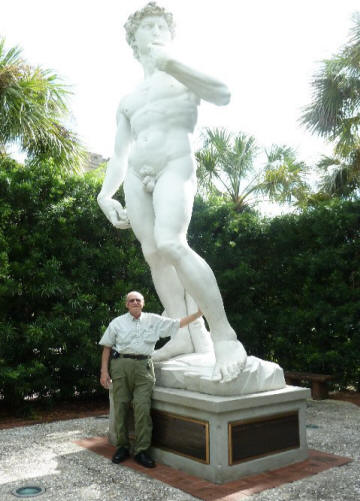 |
|
Author with Ripley's hidden David
|
The Hotel Alcazar was purchased in 1946 by Ohio newspaper
magnate Otto Lightner and reopened as the Lightner Museum
housing, on 3 floors, an eclectic collection of the
treasures of America's Gilded Age and probably every family
heirloom your descendants ever sold or discarded.
All of the athletic facilities previously mentioned have
been retained as museum pieces except for the swimming pool
which today is home to the Alcazar Restaurant and various
retail shops.
Florida and Henry Flagler are
synonymous, but no more so then in St Augustine where Henry
Flagler and his family are buried in the church he built.
A few blocks north of the Old City's North Gate is
the first Ripley's "Believe it or not Museum." The building
was previously a hotel owned and operated by Marjorie Kennan
Rawlings author of The Yearling, Cross Creek & other books.
There is one item here not shared with any of the other
Ripley museums.
Surrounded by a tall ficus hedge,
planted so as not to offend passersby's by the unclothed
depiction of the male form is DAVID, one of only two full
scale reproductions of the original in Florence, Italy. It
was carved from a block of marble quarried in the same
Italian quarry as the original and was commissioned for the
1963 New York World's Fair.
 |
|
Docents at Fountain of Youth
|
The Castillo de San Marcos is St. Augustine's signature
attraction and the oldest masonry fort (coquina stone) in
the Continental United States.
Construction of the fort began in 1672, one hundred and
seven years after incorporation of St. Augustine. Its
construction took 23 years. The Castillo de San Marcos was
attacked twice in the 1700's but was never taken by an
invading force.
There are self-guided and docent led
tours of the inside of this historic fort. Visitors even
learn of the time when the United States imprisoned leaders
of the Seminole Nation here.
The Fountain of
Youth is one of Florida's oldest tourist attractions and had
remained unchanged for generations. If you visited it once,
there was no reason to return. But now
descendents of the original owners have brought life back to
the old girl.
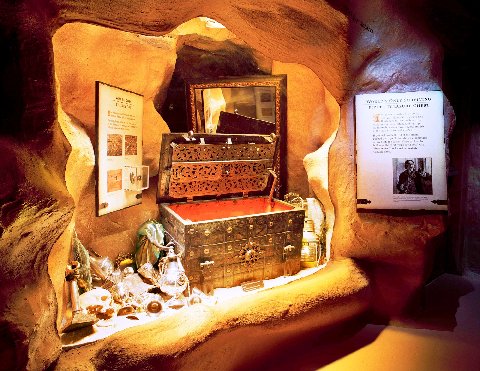 |
|
Only existing authentic pirate's treasure chest
in the world
|
Archeologists have uncovered foundations of early Native
American and Spanish villages. Restorations are
underway to recreate prior habitations and special events
are featured throughout the year.
The
new St. Augustine Pirate & Treasure Museum was in Key West
for 5 years until its owner Pat Croce, former owner of the
Philadelphia 76ers, realized Key West was a party town.
He moved his treasures lock, stock, and musket to St.
Augustine where it opened in late 2010. The only remaining
pirate's treasure chest in the world, purchased by Mr. Croce
for $1 million, is displayed inside.
The museum is
a touchy, feely place. Almost everything here is to be
handled including two authentic old cannons which can be
fired, my favorite thing to do, electronically.
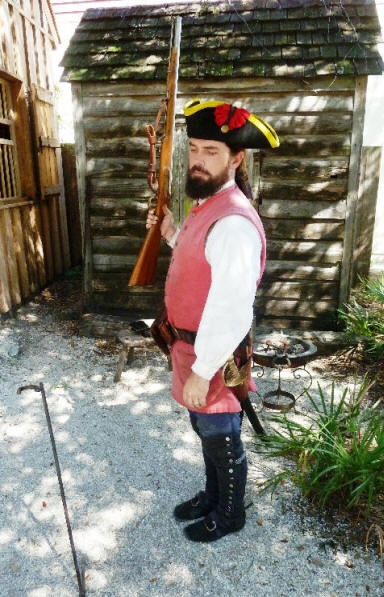 |
|
Docent at Colonial Quarters
|
The museum, located directly across from the Castillo de San
Marcos, became an instant success when opened to the public
and continues to draw people of all ages.
Backing up to pirate's museum, where the Spanish Quarter
once stood on King St., is the brand new Colonial Quarter
(also a Pat Croce project) featuring three centuries of
Spanish and English occupation. Costumed tour guides walk
visitors through the centuries while village "residents"
busily work at their trades.
At the downtown
Municipal Marina, visitors can take guided eco-tours, a
two-hour bay tour on the tall ship FREEDOM under full sail
or be entertained by a trip on the BLACK RAVEN, a
painstakingly detailed reproduction of a pirate ship.
As a frequent visitor to St. Augustine, I'm frequently asked
where to stay. That is a subjective call. There
are many fine inns and hotels.
One of my favorites is
the St. Francis Inn. It is the oldest continuously
operating inn in the oldest continuously occupied European
city in the Continental US and run by Joseph Finnegan who
bills himself as the oldest inn keeper of the oldest inn in
the oldest city.
The original
structure, a 1-story building, was built in 1791 with the
first travelers being hosted in 1845. The Inn
was expanded over the years now has 3 stories plus some
adjoining residences. It is not a cookie cutter motel.
An added benefit for guests is their St. Augustine beach
front building available to guests for daytime use.
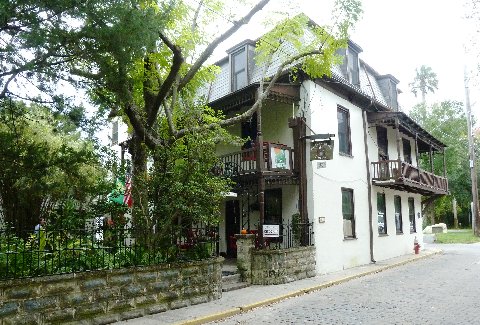 |
|
St. Francis Inn
|
The question of dining availabilities always comes up.
Walking to restaurants in the Old City is normally a
pleasant stroll but a listing of places to eat, even
briefly, where Spanish, Minorcan, French, Greek, Italian,
American and other cultures are represented would take more
room than I am allowed here. Even this article is but a
brief capsule of things to do and see in St. Augustine.
Many towns and cities along the coast, from Jupiter north,
claim to have been the place where Ponce de Leon actually
landed. No matter, St. Augustine has a lock on the
claim and has made the most of it over the years, especially
during this the 500th anniversary year of Ponce de Leon's
purported landing.
The next big celebration will be in 2065 for the 500th
anniversary of the founding of the city. This will be
something for our children and grandchildren to celebrate.
Thankfully St. Augustine's history will be preserved and
not torn down to put up high-rise condos or gated
communities.